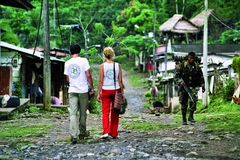
Volunteers Luigi Cojazzi (Italy) and Joke Reijven (The Netherlands) in the Peace Community of San José de Apartadó [Photo: Jorge Mata/Surimages-IPA]
Article published in the special Newsletter '15 years of PBI', October 2009
Andrew E. Miller, volunteer from the USA (1999 – 2000)
Amidst massacres and threats against the San José de Apartadó Peace Community, PBI launches a permanent presence in the region.
My deployment to Urabá as a PBI volunteer – from April of 1999 through the end of February, 2000 – began and ended with massacres. The first night in Turbo, several human rights workers with CIJP came by the house to show us a video. It featured an interview with Catalino, an ex-community leader from Chocó, announcing that he had switched sides and from henceforth would be a member of paramilitary group under Carlos Castaño. Having just arrived, I didn’t understand much of what he said. But the seriousness of his words was reflected in the horrified expressions of my new colleagues. They told me that he had accused even the nuns of the region of being ostensible guerrilla collaborators. The reaction that almost inexorably follows this kind of public accusation in Colombia was not long in the coming.
The following evening, a Sunday, a paramilitary unit entered the San José de Apartadó Peace Community. The paramilitaries killed three people, including Aníbal Jiménez, one of the community’s founders1. Such is the «logic of the war»: terrorise the community to annihilate their resistance to the different armed groups. PBI did not have a physical presence in the town when the attack happened; they phoned us in the middle of the bloody events. Back in Turbo, I learned how a PBI «activation» functioned, starting with rapid-fire phone calls all night long and a departure for the community at first light the next morning.
Over the coming days, paramilitary soldiers spread out across the Lower Atrato river region. Groups of armed men entered different riverside hamlets belonging to the San Francisco de Asís Peace Community, around the town of Rio Sucio, and killed at least 12 people2. They also abducted a number of community leaders, to have a forced dialogue with Carlos Castaño about Catalino’s version of events. The leaders denied the accusations as false and were eventually let go. But they continued to fear for their lives.
Such was my welcome to Urabá. I was asking myself, «Damn, is this what happens here every weekend?» Later I would realise that these events were indicative of a new stage in the evolution of the region’s armed conflict.
At that moment, the people from Cacarica who had been displaced by Operation Genesis in 1997 were still found in Turbo’s coliseum and other urban settlements. Each day we would do the rounds, visiting the displaced camps because the people responsible for the displacement were often seen around town. From time to time we would accompany groups of Afro-Colombian workers who were harvesting some small parcels outside of Turbo and displaced community leaders in their daily activities.
With the assistance of the Intercongregational Commission of Justice and Peace, the displaced in Turbo were organising a mass return to their territories, just south of the Darien Gap (border with Panama). Over the course of 1999 they set different dates, but the security and other conditions weren’t conducive and they had to postpone several times. In October, we accompanied what was called The Exploration, or several field missions in preparation for the return. For me personally, it was one of the most significant experiences during my year. We would spend a week at a time with a group of roughly eighty displaced people in their home territory, which offered an opportunity for more personalised interaction. I sensed a change in the morale of these folks who, at long last, had escaped the confines of the Coliseum for their fecund lands with an obvious joy.
Meanwhile, the threats against San José de Apartadó increased. Priests with the local church told us that Carlos Castaño had personally accused the community of supplying the guerrillas and lending them the community telephone in order to organise kidnappings and killings along the Banana Axis. From that moment on, PBI initiated a permanent presence within the community and intensified our preventative political work in order to avoid a new incursion. We were concerned that something would happen over the holidays. We were wrong about the date, but our fears were not misplaced.
One weekend in February I went to the Peace Community on a routine accompaniment. Along with my fellow volunteer, Jorge Ruiz, I walked up to La Union, an outlying hamlet about an hour and a half from San José. We came back down that afternoon to have dinner with the community leaders and the full-time Justice and Peace workers. As we finished dinner, we settled in to watch the nightly news at 7:30. Just as the program started, we were frightened by tremendous sounds coming from the central plaza, just outside our building. BOOM, BOOM. BOOM. Gunshots from high-powered rifles echoed through the valley. Immediately we could see the silhouetted figures of camouflaged, armed men walking within the community. We would realise later that they had already shot their first victim, Albeiro Montoya.
During the incursion, several groups of armed men looked for their targets with the assistance of two hooded men who did the identification. In the billiards hall they found the town baker, Mario Urrego, who had sold me bread the week earlier. According to a witness, he said, «Don’t worry, it’s just the Army»3. He should have worried. The armed men forced Urrego to stand in the doorway to his house where they killed him with a shot to the head, in front of his family. Similarly, they continued with two small shop owners, Luis Ciro and Alfonso Jiménez. Finally, they entered an evangelical service, which continued during the whole attack amidst the unmistakable sounds of gunshots. They grabbed a young man, Uvaldo Quintero, and assassinated him at point-blank in the street 4.
Jorge and I stayed up in the Missionary House with the community leaders and Justice and Peace accompaniers. Using our satellite phone, we called the PBI house in Turbo at three-minute intervals, informing the team of the situation. For their part, they phoned the office in Bogotá, which in turn made a series of national and international calls. In the meantime, we positioned ourselves at the top of the stairs in case the armed men decided to enter and come up. Fortunately, they didn’t.
Twenty-five minutes after it all started, we received news that the armed group had left along the road towards Apartadó. As documented by Justice and Peace, multiple witnesses provided information that pointed toward the incursion being a joint operation between members of the Army’s 17th Brigade and paramilitary soldiers. There had been significant military presence around the community during the day. One of the hooded men was identified as a former guerrilla who had surrendered to the Army the previous month.
We maintained guard, along with members of the community, for the rest of the night. Few people could sleep, out of fear of another incursion. In the morning, two Brigadistas arrived to replace Jorge and myself. I remember leaving with a tremendous feeling of shame for not having been able to avoid what happened. I thought, «Now I get to leave while the community members have to wait here for the next atrocity».
Prior to these events, I had dreamt of accompanying the first wave of returnees to Cacarica, which finally happened on 1 March 2000. However, I ended up missing the occasion by one day, as I left Turbo on February 28th toward Bogotá and ultimately my country. Within the Project we had decided that the most strategic use of my time would be to push the case of the Peace Community in Washington, DC. With the support of allies there, I carried out an advocacy campaign with the US Congress and presidential administration. Three months to the day after the massacre, a letter signed by 49 members of the Congress’ House of Representatives was published, expressing serious concerns about what happened in San José de Apartadó.
As such I ended my year with PBI, having learned through my personal experience that international presence is not enough to stop Colombia’s conflict in all its brutality. We don’t have a special power to turn bullets into flowers as they mark their victims. The community members and the valiant people who work in defence of human rights, however, continue to ask for Peace Brigades’ presence. They continue to say, «Please, don’t abandon us». Even with all their difficulties, ten years later, Uraba’s communities in resistance have persisted. And PBI has not abandoned them.
1 «Colombia: Retorno a la esperanza – Las comunidades desplazadas de Urabá y del Medio Atrato», Amnesty International Report, June 2000 (pages 13-14)
2 Ibid
3 Letter written by the Inter-Congregational Justice and Peace Commission to President Andrés Pastrana Arango, 20 February 2000
4 Urgent Action, Amnesty International, 21 February 2000
--
Three years building together
Juan David Villa Gómez, CINEP team in Urabá (1999 – 2002)
In 1999, the communities in the Bajo Atrato river basin in the Chocó department were slowly returning to their lands. We accompanied this process together with the Apartadó diocese and the priests from the Riosucio Claretian parish. At this time, the Centre for Research and Popular Education was working with limited resources. For us, this situation represented a risk because of the conditions in the region, wide expanses of land without access through which we had to travel in small boats, our only protection being a religious symbol or a flag. Given the situation and without having received any specific threats, we thought that PBI’s field accompaniment could dissuade the armed actors from attacking us and contribute to our ability to mobilise our organisation to act before the state authorities.
For us, the presence of PBI was symbolic, a testimony, an abstract presence that is now called the «international community». People that believe in our cause from so many different countries that left a safe and comfortable place behind in order to share their destiny with those of us who are trying to build a better world in the midst of conflict, war and death. During those three years, PBI was our point of reference on security and protection issues, not based on force, but simply on the presence, faith and belief that another world is possible and in the belief in the value of life and the need to make respect for human rights real.
